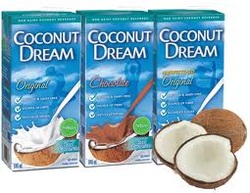 I recently noticed coconut milk as a new addition in the non-dairy milk section at the grocery store. My wife currently has love affair with all things coconut so we picked up a few containers to try. For a number of years I have been avoiding dairy products, especially dairy milk. Dairy products are one of the most common food sensitivities that I see in clinical practice so we try to avoid it if possible. Many of us have a number of food sensitivities that can cause symptoms such as indigestion, diarrhea, frequent colds, bloating, chronic sinus congestion and acne to name a few. For more information please read my post on Food Allergies and Sensitivities Explained. I have been a big fan of dairy milk alternatives for a number of years. The majority of my patients eliminate dairy products to some degree as part of their dietary treatment plans. This one small simple change often yields substantial improvements in a number of symptoms you would never think are related to what you are eating. This change has been made so much easier with so many non-dairy alternatives that not only are free of common allergens but also taste great. The taste factor has always been one of the biggest stumbling blocks and I was interested to see how coconut milk (that can be consumed as a drinking beverage or with cereals, not the type used in asian cooking) stacks up against the other options. Before I give you my verdict on coconut milk, I wanted to give you a taste and nutritional value assessment of the most common non-dairy milk options available. The flavours that I compared where all original flavours to level the playing field. There are a number different flavours available but always be aware of higher sugar content in flavoured milks. Also, as a reference point I have rated the taste of dairy milk a 4 out of 5 stars so you can see how the milks below stack up. Soy Milk: The first and most commonly available dairy milk alternative. There is some controversy surrounding this beverage, questioning if long term use is healthy (especially for men) because soy can act like the hormone estrogen in the body. Some studies show benefit to menopausal symptoms and cancer prevention in women, others show none. The verdict is still out but overall it appears to be safe. Key nutritional points: Fortified with calcium, B-vitamins and magnesium PROs: Higher in protein, source of magnesium, source of phytoestrogens, possibly beneficial for cardiovascular health, dairy free CONs: High allergenic potential (soy is very common allergen), unknown effects in mens, all soy is GMO Taste: Most people like the taste and consistency (3.5/5 stars) Bottom line: Soy milk is a better alternative than dairy milk with some potential health benefits but I don't recommend long term use (over 2 month at a time). If you are not sensitive to it (don't feel worse after drinking) then you can drink it as a change from other milks discussed below. Almond milk: The emerging favorite alternative to soy milk that is now widely available. Many health benefits are associated with almond intake. Key nutritional points: High in magnesium, low in fat, great source of calcium PROs: Very low allergenic potential, high in magnesium and calcium, soy and dairy free, available at costco to buy in bulk. CONs: low in protein, taste is bland (original), not all people like the flavour, can be higher in sugar depending on brand Taste: Really hit and miss with most people, the original flavour as unique taste which some would called "acquired" (3/5 stars). Bottom line: One of my go-to dairy alternatives because of the low allergenic potential and solid health benefits. The unsweetened or original is actually great if mixed with oatmeal, quinoa or cereal (not that great to drink by itself). This is my milk of choice for breakfast and in protein shakes. Rice milk: Another alternative to soy with low allergenic potential Key nutritional points: Low allergenic potential PROs: Soy, gluten and dairy free, low in sodium CONs: As with almond milk the taste can be plain or considered as 'acquired' Taste: Can vary between brands but generally very little taste (which can be good or bad depending on the person) (3/5 stars) Bottom Line: I like rice milk as an alternative to almond milk if patients don't like the taste or need to switch up flavours. Oat milk: A newer option. It's not widely available yet. Key nutrition stats: Higher in fibre PROs: Oats are higher in fibre then soy, almonds or rice, low in saturated fat CONs: Oats can still contain gluten which is highly allergenic Taste: Average taste. Some people like it better than rice or almond milk. Its all about personal preference (3/5 stars) Bottom line: can't really comment much on this milk since it don't use it often but I think its a good alternative. And now finally coconut milk. Lets see how it stacks up vs the above options. Coconut Milk: New kid on the block that is gaining popularity with the emergence of coconut as a new "superfood" Key nutriton stats: despite containing saturated fatty, it does contain medium chain fatty acids PROs: Contains medium chain fatty acids that help with energy production and weight loss, great taste CONs: Higher in sugar, no protein, fibre or magnesium, slightly more expensive than almond or rice Taste: Best surprise is the great taste and palpable consistency. It has a mildly "coconutty" flavour with a light consistency. It is great in cereal or by itself. (4.5/5 stars) Bottom line: This is a welcome addition to the dairy free line up. Great taste with medium chain fatty acids as a source of good fat and energy. Don't worry about the saturated fat. Rather avoid sugar instead as it has much more powerful effects on cardiovascular disease. So in conclusion, coconut milk has now been added to our shopping list as an alternative to rice or almond milk. The only downside is that it is not that readily available and the price is a little more expensive than the other options, but the superior taste makes it a great gluten-free, dairy-free and soy-free option. It is one of the only options that I really enjoy drinking on its own as it it were a glass of dairy milk. The future looks even better as there now is a coconut and almond milk combination available . I can't wait to try it. If you can't decide between the options I recommend to first try all of them at least once (give it a fair chance since the taste can grow on you) and don't expect them to taste like diary milk. Find the types you prefer and then use each one for a period of time and then switch. This provides variety in the taste and nutrition without you getting tired of one flavour. I hope that clarifies the world of non-dairy milk options. Enjoy
1 Comment
8/27/2012 08:15:46 pm
Very interesting post thanks for sharing this valuable information.
Reply
Leave a Reply. |
Welcome To My Blog
My goal is to post thought-provoking and informative articles so you can learn and apply the latest news from the world of natural health. Feel free to post comments and start a conversation. Stay tuned to my twitter and facebook feeds for the latest posts.
Archives
December 2015
|

 RSS Feed
RSS Feed

